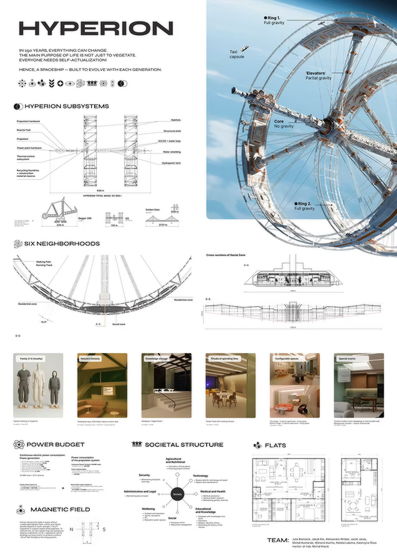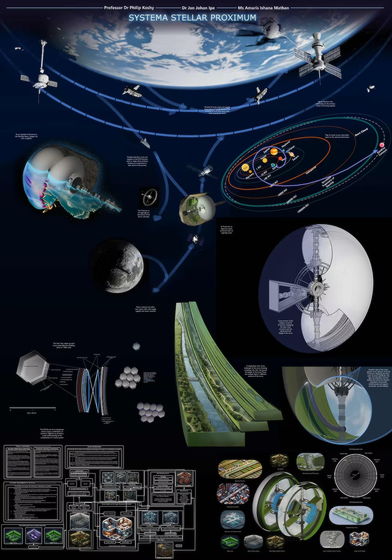Project Hyperion is a competition to explore the feasibility of a 'generation spaceship' capable of supporting multiple generations of humanity.

Project Hyperion is a design competition to evaluate the feasibility of
Project Hyperion | interstellar generation ship design competition
https://www.projecthyperion.org/

'Project Hyperion' is a design competition exploring the feasibility of human interstellar flight via an interstellar or generation spacecraft. A generation spacecraft is a fictional spacecraft designed for long-duration interstellar travel, potentially taking centuries to complete. The generation spacecraft is envisioned as a spacecraft in which the initial crew can live and reproduce on board, and after death, their descendants can continue the journey until they reach their destination. It is envisioned as a self-sustaining ecosystem, with agriculture, habitation, and other necessary life support systems to ensure survival over multiple generations.
The Interstellar Research Initiative ( i4is ), organizers of Project Hyperion, describe the competition as 'a groundbreaking international contest challenging interdisciplinary teams to conceive a Generation Spacecraft – a crewed interstellar spacecraft designed for a 250-year journey to a habitable planet.'
Project Hyperion will require architectural designers, engineers, and social scientists to work together to envision the elements needed for a generational spacecraft that could function as a closed society for centuries. Collaboration between different disciplines will be key to finding comprehensive solutions that meet complex requirements.
The following elements are required for a next-generation spacecraft:
- Space that can accommodate 1000±500 people for several centuries
・Artificial gravity through rotation
A society that ensures good living conditions, including essential provisions such as housing, clothing and other basic needs.
Robust life support systems for food, water, waste and atmosphere
- Knowledge transfer mechanisms to maintain culture and technology
The top three winners in the competition were:
◆1: Chrysalis

The jury commented on Chrysalis, 'Chrysalis impressed the judges with its systems-level coherence and innovative design of the modular habitat, as well as the depth of overall detail, including the value of manufacturing in space and pre-mission crew preparation in Antarctica. The modular shell design promotes flexibility and connectivity, supporting both functionality and scalability. The massive dome structure adds a dramatic, cinematic quality reminiscent of classic science fiction. The systems-level overall plan, encompassing not only the architecture but also the hull construction method, is extremely powerful. The radiation protection strategy is solid and the pragmatic structural approach is appropriate. While the culture system has room for further development, the concept provides a compelling starting point. The presentation is rich and visually appealing, drawing comparisons to iconic works such as '
◆2: WFP Extreme

WFP Extreme was highly praised for its overall excellence. It placed particular emphasis on cultural and social aspects, including concepts like clothing and spiritual space, and the judges described it as 'an outstanding achievement in cultural and social considerations' and 'the most thoughtfully developed idea in its field.' The architectural design incorporates advanced technologies such as radiation protection, and features ingenious touches such as a taxi capsule and special clothing for the crew. The judges also noted that 'while there is room for further development in the system-level consistency of artificial gravity and the interior design, the structural approach is suitable for use in orbit.'
◆3:Systema Stellare Proximum

Systema Stellare Proximum is a concept that presents an imaginative narrative that thoughtfully weaves together the social, technological, and cultural aspects of long-term space habitation. The jury stated, 'Systema Stellare Proximum stands out with its immersive storytelling that seamlessly connects technological, social, and cultural dimensions.' The storytelling is compelling, with an original scenario that explores everything from community dynamics to spirituality, highlighting the role of shared values in building a resilient , intergenerational society.
'While the physical feasibility of a thin-shell asteroid needs further refinement, the concept demonstrates a solid understanding of the challenges of space radiation,' the judges wrote. 'The system-level planning is meticulous, and the presentation is detailed and visually dynamic, enhanced by artistic illustrations. This submission impresses with its comprehensive vision and poetic approach to deep space life.'
Related Posts:
in Note, Posted by logu_ii







